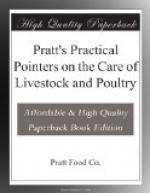Breed. Cock. Hen.
Leghorns 5 1/2 lbs. 4 lbs.
Black Minorcas 9 lbs. 7 1/2 lbs.
Plymouth Rocks 9 1/2 lbs. 7 1/2 lbs.
Wyandottes 8 1/2 lbs. 6 1/2 lbs.
Rhode Island Reds 8 1/2 lbs. 6 1/2 lbs.
Orpingtons 10 lbs. 8 lbs.
Light Brahmas 12 lbs. 9 1/2 lbs.
Most of these breeds have varieties, determined by color of plumage or shape of comb. Select that one which best pleases you.
[Illustration: UNEVEN SPAN ROOF HOUSE]
Poultry Houses
When locating the poultry house remember that it is a great advantage to have soil which is light and naturally well drained, since such soil dries off quickly after a rain and is “much warmer,” as poultrymen express it. Heavy soil, even stiff clay, may be made to serve the purpose admirably if provision is made to drain off all surface water. But avoid a site on which water settles in pools, as the surface soon becomes filthy and is a menace to the health of the flock.
[Illustration: NEW JERSEY MULTIPLE UNIT HOUSE Two units combined to house two hundred fowls]
The birds should have the benefit of several hours of sunshine each day. So locate the poultry house where the sun can strike it freely. The shelter of tall buildings on the north, or even on the east or west, is frequently an advantage during the winter months, but the south side should be open if conditions permit. Shade trees and large shrubs about the house are a source of comfort to the fowls during hot weather and may be used to screen or partially hide the poultry plant.
The poultry house must be dry, well-ventilated, free from draughts, light, sunny and cheerful. And if it is planned with reference to the convenience of the poultryman, so much the better. The most simple and inexpensive form of construction should be used. In all sections of the country, excepting the extreme north, a single wall of matched boards on a light frame is perfectly satisfactory. Unmatched boards with battens nailed over the cracks or a layer of lightweight roofing paper over all are equally good. In fact, in case of necessity, one may use the roughest of lumber, and by covering the entire structure with roofing paper make a building which is tight and comfortable and acceptable in appearance.
The rear and end walls and roof must be tight to insure dryness and prevent all draughts. Windows and doors may be placed in end walls, but these should usually be located forward of the center of the building and made to fit snugly. The rear part of the house, where the roosts are located, must at all costs be protected against cross-currents of air.
[Illustration: ROOST]
The south or front walls, on the other hand, should have ample openings to admit air and sunshine. The open-front or fresh-air type of house is much superior to the old tightly closed type. Plenty of fresh air means comfort, health, vitality and increased production.




